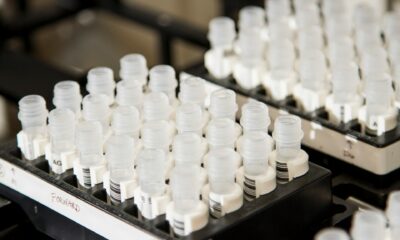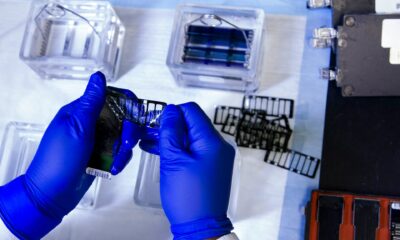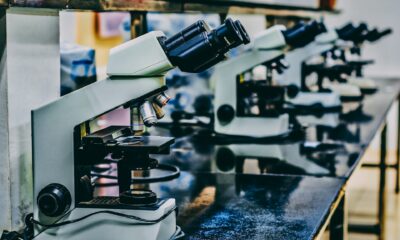Biotech
Pharmaceutical companies in Spain beat their record investment in R&D: €1.2 million
Within the pharmaceutical investment in research and development it is necessary to distinguish between different parts of the process. Almost $78 million (€66 million) were allocated to the pre-clinical research chapter (preliminary trials of new drugs, normally on animals) and $842.8 million (€713.5 million) to the clinical phase (when the drug begins to be tested on humans).

New investment record for the pharmaceutical industry in Spain. Throughout 2019, companies in this sector operating in the country invested $1.42 million (€1.2 million) in R&D. This is the highest figure for this area, with growth of 5.4% over the previous year and represents an average annual rate of 4.8% over the last decade. Of the aforementioned amount, $808 million (€684 million) were destined for their own factories and laboratories and $623.7 million (€528 million) went to hospitals, universities, and public and private organizations.
Read more details about the number of investments made by Spanish pharmaceutical companies in R&D and find the most important business news with the Born2Invest mobile app.
Moreover, the industry is increasingly focusing its investment on external centers
In the last ten years, the weight of the extramural chapter has increased by 3.6% and now represents 43.6% of the total investment made by pharmaceutical companies in Spain. In fact, the majority of the $623.7 million (€528 million) remains in the country and only 14.7% leaves the borders. In the last ten years, moreover, the weight of extra-mural investment that stays in Spain has grown from 79.7% to 85.3%.
By autonomous community, Madrid and Catalonia are the regions that have received most of this investment, with Andalusia and Valencia lagging far behind. In the last ten years, the Spanish capital has grown by 10 points in its capacity to collect this investment.
Within the pharmaceutical investment in research and development it is necessary to distinguish between different parts of the process. Almost $78 million (€66 million) were allocated to the pre-clinical research chapter (preliminary trials of new drugs, normally on animals) and $842.8 million (€713.5 million) to the clinical phase (when the drug begins to be tested on humans). Within the latter amount, 50% was allocated to the last phase of research of a drug before it is marketed. In comparison with what was happening a decade ago, both Phases III and I gain weight, which means that Spain continues to be a capital for the sector.
The rate of employment in R&D increased during 2019
The pharmaceutical industry is one of the industrial sectors with the largest number of highly qualified workers. Within the personnel assigned to R&D, direct employment grew by 4.2% in 2019, reaching 5,006 people working. This figure has been growing over the last five years and has also broken the sector’s historical record. Since 2015, there are 750 more people working in this field.
The employment, besides in the research area, is qualified in the whole industry. Only 12% of the staff are unqualified. In the last ten years, moreover, hiring has become more specialized and today, the percentage of people with a higher degree or a postgraduate degree represents 87.8% of the total number of workers.
The industry allocates 100 million to drug evaluation processes
This is the amount the industry allocates to drug evaluation processes once they are approved by the authorities. They are mainly destined to pharmacoeconomic studies, to show their value in the current therapeutics, epidemiology and post-authorization studies, to see the activity of the drug in real life.
__
(Featured image by Chokniti Khongchum via Pexels)
DISCLAIMER: This article was written by a third party contributor and does not reflect the opinion of Born2Invest, its management, staff or its associates. Please review our disclaimer for more information.
This article may include forward-looking statements. These forward-looking statements generally are identified by the words “believe,” “project,” “estimate,” “become,” “plan,” “will,” and similar expressions. These forward-looking statements involve known and unknown risks as well as uncertainties, including those discussed in the following cautionary statements and elsewhere in this article and on this site. Although the Company may believe that its expectations are based on reasonable assumptions, the actual results that the Company may achieve may differ materially from any forward-looking statements, which reflect the opinions of the management of the Company only as of the date hereof. Additionally, please make sure to read these important disclosures.
First published in elEconomista.es, a third-party contributor translated and adapted the article from the original. In case of discrepancy, the original will prevail.
Although we made reasonable efforts to provide accurate translations, some parts may be incorrect. Born2Invest assumes no responsibility for errors, omissions or ambiguities in the translations provided on this website. Any person or entity relying on translated content does so at their own risk. Born2Invest is not responsible for losses caused by such reliance on the accuracy or reliability of translated information. If you wish to report an error or inaccuracy in the translation, we encourage you to contact us.

-

 Impact Investing2 weeks ago
Impact Investing2 weeks agoEU Eases CO2 Tax Burden on SMEs with Revised CBAM Rules
-

 Fintech3 days ago
Fintech3 days agoRobinhood Expands to Europe with Tokenized Stocks and Perpetual Futures
-

 Business1 week ago
Business1 week agoAmerica’s Debt Spiral: A $67 Trillion Reckoning Looms by 2035
-

 Crowdfunding7 days ago
Crowdfunding7 days agoTasty Life Raises €700,000 to Expand Pedol Brand and Launch Food-Tech Innovation

























